Mitsubishi Motors Bundle
How is Mitsubishi Motors Revitalizing Its Sales and Marketing Game?
Mitsubishi Motors has dramatically reshaped its approach, particularly with the groundbreaking Mitsubishi Motors SWOT Analysis, signaling a bold move into the electric vehicle market. This transformation reflects a strategic pivot towards sustainability, aiming to attract environmentally conscious consumers. From its industrial roots in Tokyo, Mitsubishi has evolved its strategy to meet the changing demands of a global audience.
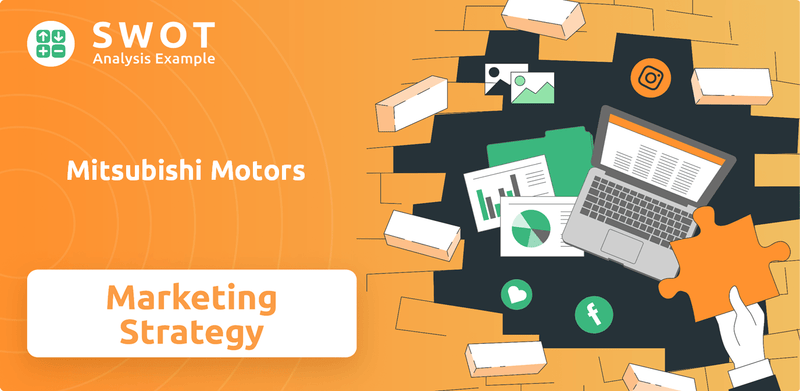
This deep dive into Mitsubishi Motors' sales and marketing strategy will explore how the company reaches its target audience through various channels. We'll examine the evolving marketing tactics used to boost brand awareness and sales, including a thorough Mitsubishi Motors market analysis. Furthermore, we'll analyze Mitsubishi Motors brand positioning within the competitive landscape and highlight impactful campaigns, offering insights into Mitsubishi Motors sales strategy and Mitsubishi Motors marketing strategy.
How Does Mitsubishi Motors Reach Its Customers?
The sales strategy of Mitsubishi Motors centers on a multi-channel approach, blending traditional methods with digital advancements to reach its diverse customer base. A key component of the Mitsubishi Motors sales strategy involves leveraging its global network of dealerships. These dealerships serve as crucial physical locations for vehicle sales, after-sales services, and the provision of genuine parts.
The company's approach involves a gradual integration of digital tools to enhance the customer journey. While direct vehicle sales through e-commerce platforms are not yet the primary model, the company's website plays a vital role in lead generation. Customers can configure vehicles, request quotes, and locate dealerships through the website. Strategic shifts include a greater emphasis on improving the digital customer experience, acknowledging the growing importance of online research and pre-purchase interactions.
The traditional dealership model still accounts for the majority of sales. However, digital adoption has influenced the sales process, with virtual showrooms and online booking options becoming more prevalent. Partnerships with financial institutions for vehicle financing and insurance further support the sales process within the dealership network. Wholesale distributors also play a role in reaching smaller markets or specific commercial fleets in some regions.
The primary sales channel for Mitsubishi Motors remains its extensive global network of authorized dealerships. These dealerships operate under a franchise model, allowing for localized market penetration and customer service. This network is crucial for new and used vehicle sales, after-sales service, and the provision of genuine parts.
Mitsubishi Motors is increasingly focusing on digital platforms to enhance the customer journey. The company website is a key tool for lead generation, allowing customers to configure vehicles and request quotes. Digital channels are vital for initial engagement and information dissemination, influencing the sales process.
Key partnerships with financial institutions are essential for vehicle financing and insurance. These partnerships support the sales process within the dealership network. This approach simplifies the purchasing experience for customers.
In certain regions, wholesale distributors play a role in reaching smaller markets or specific commercial fleets. These distributors ensure wider market coverage. This strategy helps to expand the company's reach.
The sales strategy of Mitsubishi Motors is a blend of traditional and digital methods, focusing on a strong dealership network and online engagement. This strategy supports the company's brand positioning and aims to capture a broader market share. The company's approach reflects a commitment to adapting to changing consumer behaviors and market dynamics. For a deeper understanding of the company's business model, consider exploring the Revenue Streams & Business Model of Mitsubishi Motors.
- Dealership Network: The primary sales channel, providing physical retail locations for sales and services.
- Digital Platforms: Utilized for lead generation, vehicle configuration, and customer engagement.
- Financial Partnerships: Collaborations with financial institutions to facilitate vehicle financing and insurance.
- Wholesale Distributors: Used in specific regions to reach smaller markets and commercial fleets.
Mitsubishi Motors SWOT Analysis
- Complete SWOT Breakdown
- Fully Customizable
- Editable in Excel & Word
- Professional Formatting
- Investor-Ready Format
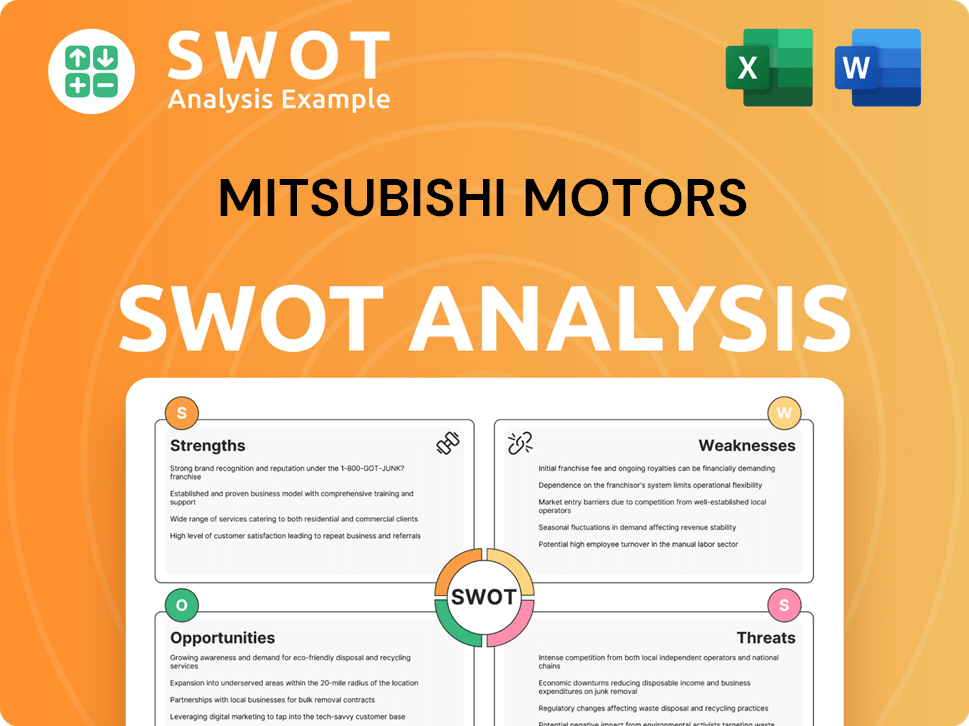
What Marketing Tactics Does Mitsubishi Motors Use?
The marketing tactics employed by Mitsubishi Motors are designed to boost brand awareness, generate leads, and ultimately drive sales. Their approach involves a blend of digital and traditional marketing channels, ensuring a broad reach to potential customers. This strategy is constantly evolving to adapt to changing consumer behaviors and market dynamics.
Digital marketing plays a crucial role, with a focus on content marketing, SEO, and paid advertising. Social media platforms are actively used to engage with customers and run targeted campaigns. Traditional methods, such as TV commercials and print media, remain important in key markets. Data-driven marketing is also a key component, helping to refine targeting and personalize marketing messages.
By combining these various tactics, Mitsubishi Motors aims to maintain and grow its market share, ensuring it remains competitive in the automotive industry. The company continually assesses its strategies to optimize performance and respond to market changes effectively. For a more in-depth look at the company's operations, consider exploring resources like Owners & Shareholders of Mitsubishi Motors.
Mitsubishi Motors utilizes content marketing through its websites and blogs. SEO ensures visibility in online searches. Paid advertising targets potential customers across various platforms.
Social media platforms like Facebook, Instagram, and YouTube are actively used. They engage customers, showcase vehicles, and run targeted campaigns.
TV commercials, radio advertisements, and print media are used in key markets. These traditional methods help reinforce brand messaging. Participation in auto shows is also vital.
Customer demographics, online behavior, and sales data are analyzed. This helps refine targeting and personalize marketing messages. CRM systems and marketing automation platforms are industry standards.
Interactive online configurators and virtual reality experiences are used. These innovations enhance the customer journey at dealerships. The focus is on adapting to changing consumer habits.
The marketing mix places a greater emphasis on digital channels. This reflects changing consumer media consumption habits. The strategy is constantly updated to optimize performance.
The Mitsubishi Motors marketing strategy focuses on a multifaceted approach to reach its target audience and increase brand awareness. This involves a blend of digital and traditional marketing methods, supported by data analysis to refine campaigns and enhance customer engagement. The Mitsubishi Motors sales strategy is closely aligned with its marketing efforts, aiming to convert leads into sales through effective distribution and pricing strategies.
- Digital Marketing: Includes SEO, content marketing, and paid advertising to increase online visibility.
- Social Media: Active engagement on platforms like Facebook, Instagram, and YouTube to connect with customers.
- Traditional Media: Utilizes TV, radio, and print advertising to reach a broad audience.
- Data-Driven Approach: Analysis of customer data to personalize marketing messages and improve targeting.
- Customer Relationship Management: Implementation of CRM systems to manage customer interactions and improve sales performance.
- Market Analysis: Continuous monitoring of market trends and competitor activities to adapt strategies.
Mitsubishi Motors PESTLE Analysis
- Covers All 6 PESTLE Categories
- No Research Needed – Save Hours of Work
- Built by Experts, Trusted by Consultants
- Instant Download, Ready to Use
- 100% Editable, Fully Customizable
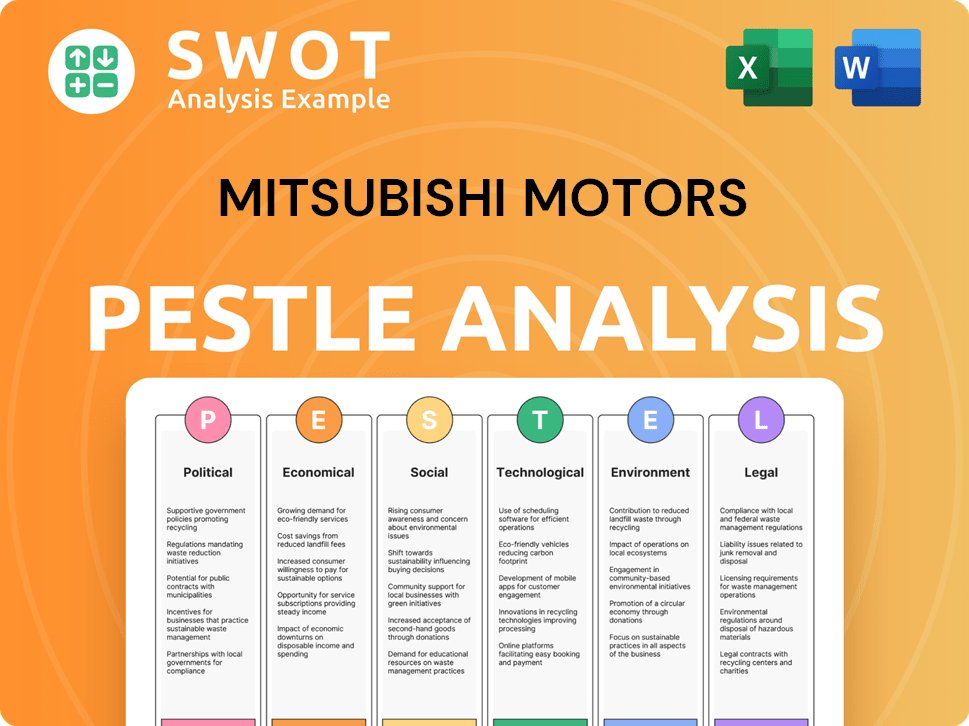
How Is Mitsubishi Motors Positioned in the Market?
The brand positioning of Mitsubishi Motors centers on reliability, ruggedness, and a growing emphasis on sustainability and advanced technology. This strategy helps differentiate the brand in a competitive automotive market. The core message often emphasizes adventure, capability, and value, attracting a target audience that seeks practical, dependable vehicles suitable for various lifestyles. This approach is crucial for understanding the Growth Strategy of Mitsubishi Motors.
Visually, the brand leverages its distinctive three-diamond logo, which represents its long history and dedication to quality. The communication tone is typically direct, confident, and approachable, highlighting the utility and performance of its vehicles. The customer experience is designed to provide dependable ownership, supported by a robust service network. This brand positioning is essential for effective Mitsubishi Motors sales strategy.
Mitsubishi Motors primarily targets value-conscious consumers, families, and those needing robust vehicles for diverse terrains or demanding conditions, particularly with its SUV and pickup truck offerings. The introduction and continued development of electric and hybrid vehicles, such as the Outlander PHEV, have also allowed Mitsubishi to appeal to environmentally aware consumers seeking innovative and fuel-efficient options. Brand consistency is maintained across its global channels and touchpoints, from dealership signage to online advertisements, ensuring a cohesive brand image. Mitsubishi Motors continuously monitors shifts in consumer sentiment, particularly regarding environmental concerns and technological advancements, to adapt its positioning.
Mitsubishi Motors focuses on value-conscious consumers, families, and those needing reliable vehicles. This includes individuals who require vehicles capable of handling various terrains and conditions. The company's SUV and pickup truck offerings are particularly targeted toward this segment, representing a key part of the Mitsubishi Motors marketing strategy.
The core message emphasizes adventure, capability, and value. Communications highlight the utility and performance of its vehicles. This approach is designed to resonate with a target audience that values practicality and dependability in their vehicle choices. This is a crucial element of Mitsubishi Motors brand positioning.
Mitsubishi is increasing its focus on sustainability and advanced technology. The introduction of electric and hybrid vehicles like the Outlander PHEV appeals to environmentally conscious consumers. This shift reflects a response to changing consumer preferences and a commitment to future marketing plans.
Brand consistency is maintained across global channels, from dealerships to online ads. This ensures a cohesive brand image and reinforces key messages. Consistency is vital for building and maintaining brand awareness, which is a key part of Mitsubishi Motors sales strategy in the US and globally.
Mitsubishi Motors is actively adapting to market changes. In 2024, the company announced plans to increase its EV sales to 50% by 2030, highlighting its commitment to electrification. This strategic move is a direct response to growing consumer demand for sustainable vehicles and is a significant part of the Mitsubishi Motors future marketing plans.
- Focus on Electrification: Increased investment in electric and hybrid vehicles.
- Market Adaptation: Responding to consumer preferences for eco-friendly options.
- Brand Enhancement: Strengthening the brand's image through technological advancements and sustainability.
- Global Consistency: Maintaining a unified brand message across all markets.
Mitsubishi Motors Business Model Canvas
- Complete 9-Block Business Model Canvas
- Effortlessly Communicate Your Business Strategy
- Investor-Ready BMC Format
- 100% Editable and Customizable
- Clear and Structured Layout
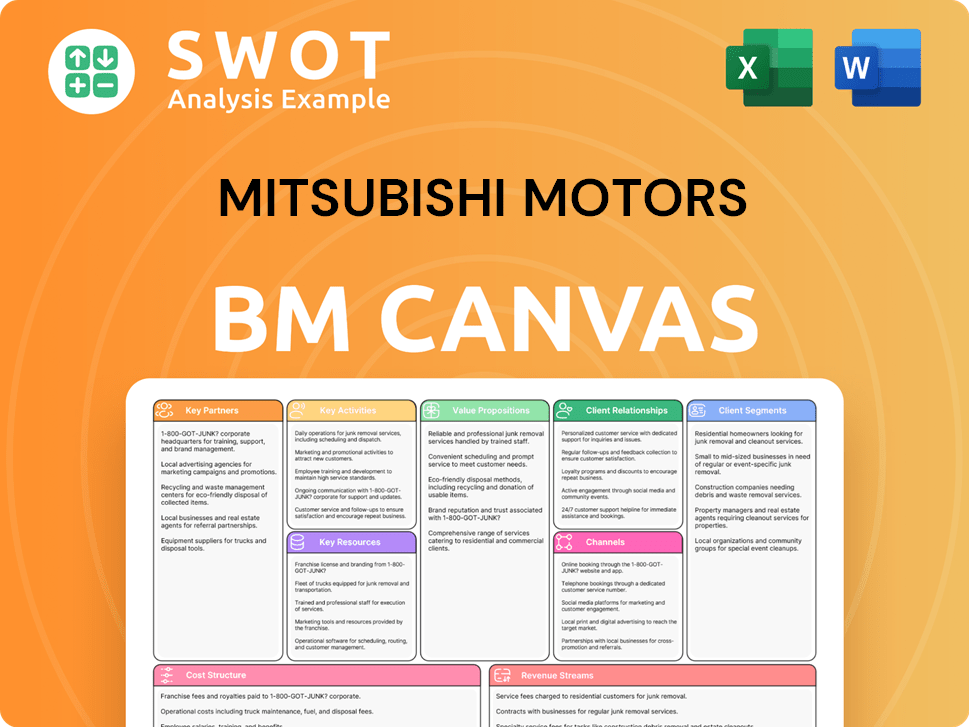
What Are Mitsubishi Motors’s Most Notable Campaigns?
The Mitsubishi Motors sales strategy and Mitsubishi Motors marketing strategy are significantly shaped by key campaigns designed to boost sales and enhance brand perception. These initiatives are carefully crafted to resonate with the target audience, driving both immediate sales and long-term brand loyalty. A deep understanding of the market and the needs of consumers is critical to the success of these campaigns.
One of the most impactful campaigns has been the focus on the Outlander PHEV. This campaign aims to position the company as a leader in the electric vehicle (EV) market by highlighting the vehicle's practicality and environmental benefits. The Mitsubishi Motors strategy has successfully established the Outlander PHEV as a popular choice in several markets, contributing significantly to overall sales. This approach reflects a broader trend in the automotive industry towards sustainable and efficient vehicles.
Furthermore, strategic collaborations play a crucial role, particularly in regions where brand visibility needs strengthening. These partnerships, which often involve local community initiatives or adventure-focused events, aim to boost brand visibility and credibility. By associating the brand with authentic experiences, the company enhances its appeal to a wider audience, strengthening its market position. The company's approach to marketing is constantly evolving to meet the changing demands of consumers and the competitive pressures of the automotive market. To learn more about the company's origins and evolution, explore the Brief History of Mitsubishi Motors.
Focuses on positioning the Outlander PHEV as a leader in affordable and practical electrified mobility. The campaign highlights the vehicle's versatility and environmental benefits, addressing range anxiety and charging concerns. This strategy has helped establish the Outlander PHEV as a best-selling PHEV in Europe for several years.
Involves partnerships with local community initiatives and adventure-focused events to boost brand visibility. These collaborations aim to create positive brand perception by associating vehicles with authentic experiences. This approach enhances the brand's appeal and builds credibility within target markets.
Employs digital advertising to reach environmentally conscious consumers and early adopters. Utilizes television commercials to showcase real-world scenarios, reinforcing the vehicle's practicality. In-dealership promotions with trained sales staff are also crucial for sales.
Adapts campaigns to suit specific regional needs and preferences, ensuring relevance and resonance with local audiences. This localized approach is essential for maximizing impact and driving sales growth in diverse markets. The company's adaptability is key to its sustained success.
These campaigns highlight the importance of clear, benefit-driven messaging and leveraging digital channels. The success of the Outlander PHEV campaign underscores the potential of focusing on practical and environmentally friendly features. The company's strategic collaborations enhance brand visibility and build credibility.
- Benefit-driven messaging is crucial for effective communication.
- Digital channels are essential for targeted outreach, especially to niche segments.
- Focus on the practical and environmental benefits of vehicles.
- Strategic partnerships boost brand visibility and credibility.
Mitsubishi Motors Porter's Five Forces Analysis
- Covers All 5 Competitive Forces in Detail
- Structured for Consultants, Students, and Founders
- 100% Editable in Microsoft Word & Excel
- Instant Digital Download – Use Immediately
- Compatible with Mac & PC – Fully Unlocked
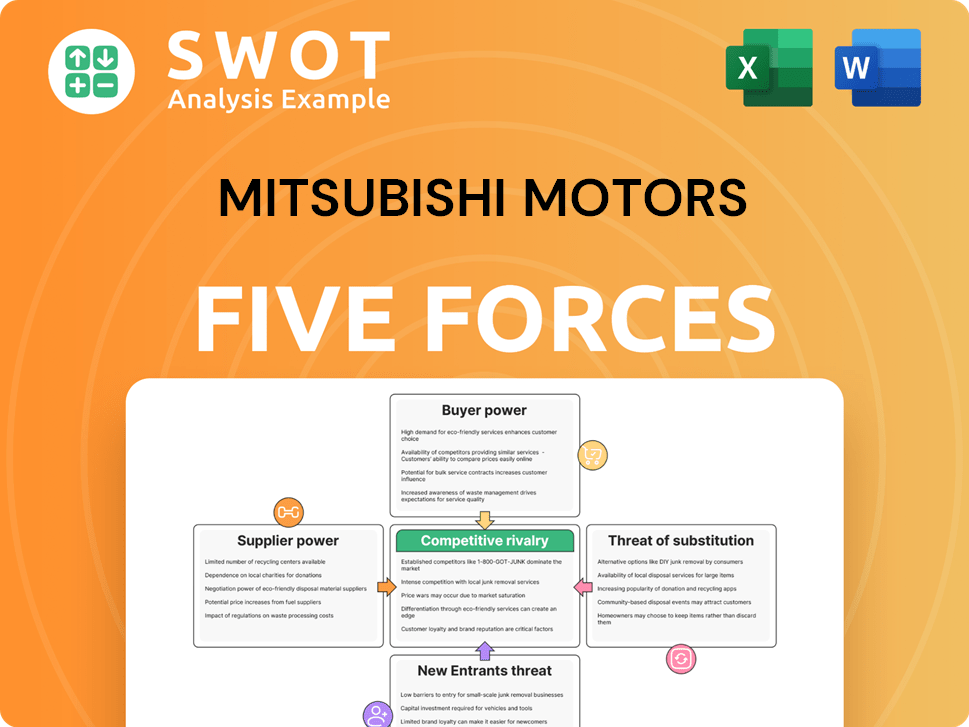
Related Blogs
- What are Mission Vision & Core Values of Mitsubishi Motors Company?
- What is Competitive Landscape of Mitsubishi Motors Company?
- What is Growth Strategy and Future Prospects of Mitsubishi Motors Company?
- How Does Mitsubishi Motors Company Work?
- What is Brief History of Mitsubishi Motors Company?
- Who Owns Mitsubishi Motors Company?
- What is Customer Demographics and Target Market of Mitsubishi Motors Company?
Disclaimer
All information, articles, and product details provided on this website are for general informational and educational purposes only. We do not claim any ownership over, nor do we intend to infringe upon, any trademarks, copyrights, logos, brand names, or other intellectual property mentioned or depicted on this site. Such intellectual property remains the property of its respective owners, and any references here are made solely for identification or informational purposes, without implying any affiliation, endorsement, or partnership.
We make no representations or warranties, express or implied, regarding the accuracy, completeness, or suitability of any content or products presented. Nothing on this website should be construed as legal, tax, investment, financial, medical, or other professional advice. In addition, no part of this site—including articles or product references—constitutes a solicitation, recommendation, endorsement, advertisement, or offer to buy or sell any securities, franchises, or other financial instruments, particularly in jurisdictions where such activity would be unlawful.
All content is of a general nature and may not address the specific circumstances of any individual or entity. It is not a substitute for professional advice or services. Any actions you take based on the information provided here are strictly at your own risk. You accept full responsibility for any decisions or outcomes arising from your use of this website and agree to release us from any liability in connection with your use of, or reliance upon, the content or products found herein.